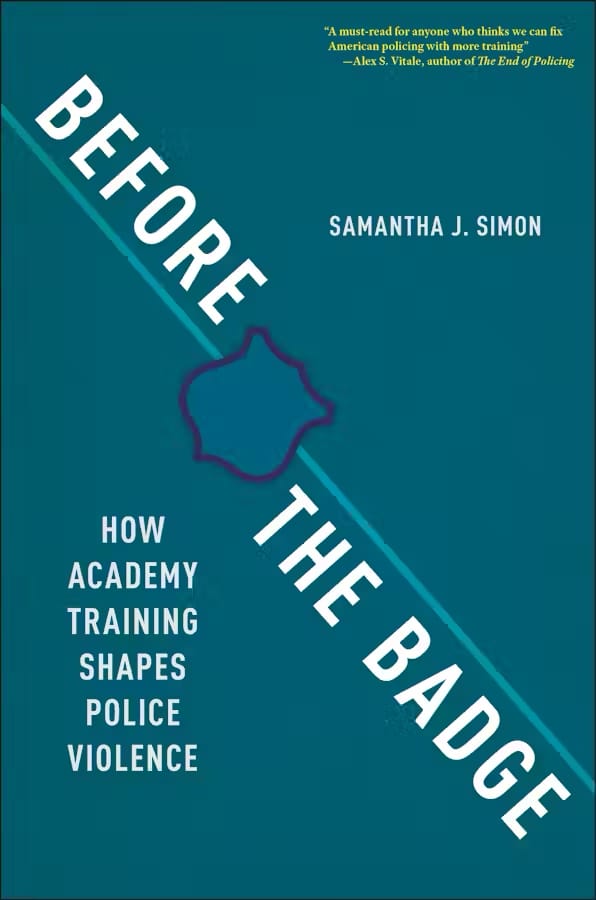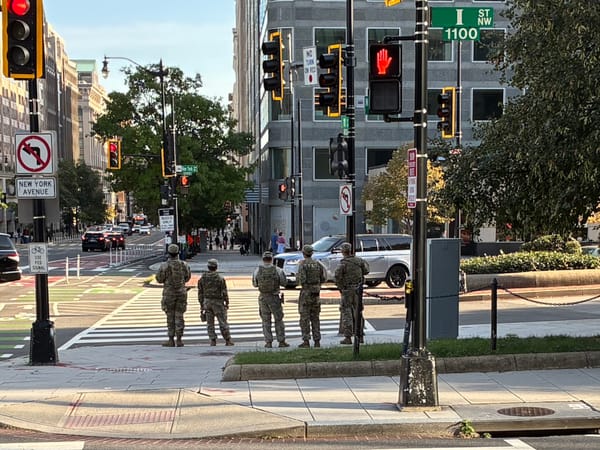Book Review: "Before the Badge: How Academy Training Shapes Police Violence," by Samantha J. Simon
A University of Arizona sociologist provides a provocative but selective and ideologically tinged look at how police in four Texas law enforcement agencies are trained and fielded and what it tells us about the viability of police reform efforts.

A University of Arizona sociologist provides a provocative but selective and ideologically tinged look at how police in four Texas law enforcement agencies are trained and fielded and what it tells us about the viability of police reform efforts.
Publisher's note: We now have a reconfigured presidential race involving one candidate on the ballot with extensive local, state, and national law enforcement and criminal justice experience. Since crime in America will definitely be a major campaign issue in 2024, I thought now would be a good time to take a look at one recent addition to the literature on the topic.
By her own admission, Samantha Simon comes from a very different upbringing and worldview than the police trainers and cadets she got to know while doing field research that ultimately turned into her book, Before the Badge: How Academy Training Shapes Police Violence, published in March 2024. From her Methodological Appendix (p. 232):
Before I started this project, I had spent almost no time in highly regimented, masculine spaces. I did not come from a first responder or military family, I did not play sports in high school, and I grew up in a mostly politically liberal Jewish community. My social circles are composed primarily of dancers, artists, and academics, so I had very limited exposure to the world of policing before I began this fieldwork.
Simon did have an aunt and uncle who were life-long cops, and she also got exposure to gun owners through a separate project prior to her police department research. But on balance, Simon's admittedly negative views on both gun ownership and policing in its current form come through clearly at various points in the book. Those views and biases detract from a work that at times does provide some valuable, revealing insights about how police are trained and shaped, at least in one of the most populous and politically important states in the country.
I give Simon all the credit in the world for plunging herself into (for her) an almost completely alien institution and organizational culture. Between the four Texas police department she researched, she put in over 600 hours of training, including weapons qualification, defensive tactics, and the rigorous physical training demands that come with any career in law enforcement or the military. The only training experiences she opted out of was being TASERed and getting drenched with pepper spray.
For Simon, the heavy emphasis on training to use physical and even lethal violence was the most disturbing part of her police academy experience, along with the overall socialization process. For Simon and other (pretty clearly left-wing) researchers she cites, this is the core issue with American policing. As she notes (p. 18):
Cadets listen to veteran officers' 'war stories,' hear warnings of unpredictable danger, and watch graphic videos of officers being beaten and killed on duty.
For Simon, such socialization and training practices "...emphasized, and indeed required, that cadets thought about and engaged in violence in ways that sustained this institution." (pp. 19-20)
It's true that on an annual basis, only a tiny fraction of police officers die in the line of duty; in 2023 138 police died on duty from a range of causes out of nearly 1 million uniformed officers. Indeed, 2023 saw the lowest number of police on-duty fatalities in over a decade. But what Simon fails to acknowledge is that however small the risk of being killed on the job might be for the average cop, that risk is never zero and no officer can know with certainty at the start of their shift whether they will, in fact, make it home alive.
Simon and other (again primarily left-wing) researchers point to racial and gender biases in policing as being major drivers of police abuse and misconduct, a view I share as it pertains to urban and suburban policing. But in largely White, rural America, I strongly suspect the story is a bit different.
In my own high school senior class, about half a dozen of my classmates went into law enforcement in Missouri, most into the Missouri State Highway Patrol (MSHP). One of those MSHP troopers is a life-long friend who retired just a few years ago.
Over the 30+ years he spent in law enforcement, we had virtually weekly conversations about the kinds of people and incidents he and his MSHP colleagues encountered along the highways and in the communities in rural southeast Missouri. From those conversations, it was clear that whether it was irresponsible motorists, drug traffickers (especially meth), or various white supremacist individuals or groups (a huge problem in rural Missouri), the encounters were most often with Whites, many of whom had prior encounters with law enforcement, including arrest and even prison time. Simon does not even address known or potential differences between policing in urban versus rural areas, which brings me to my major issues with Simon's book.
Methodological approach and sample size: Her research was centered on four law enforcement agencies (LEAs) in urban areas in a southern state (Texas) with 2700 police departments, an incredibly small sample size that she essentially uses to draw conclusions/generalizations regarding national policing practices, patterns, etc. Clearly, it would be impossible for her or any other single researcher to attend every training academy in the state (nobody could even if all LEAs granted permission), but she does not admit the limitations of relying on such a small sample size.
Additionally, she states that she is influenced by feminist and queer ethnographic approaches to research, to wit (p. 246):
Rather than striving for a distanced, objective approach to scholarship, feminist and queer methodologies acknowledge the researcher’s capacity to shape, and be shaped by, the research process.
That approach is not one well suited to a truly rigorous examination of a topic as complex, layered, and politically fraught as the state of policing in America. It is also at odds with most forms of political and social science research that are considered sound with an emphasis on striving for genuinely objective, empirical, replicable results that can actually be used as a rational basis for policy proposals.
Use of force: As I noted above, Simon is critical of the extent of use of force (UOF) training but provides no data on actual UOF incidents for the departments in question and whether the departments were located in areas with high illegal gun trafficking, drug running, armed robberies, etc. Were the LEAs she selected sued frequently over UOF incidents, had a high number of UOF complaints, etc.? Simon provided no data on these questions and no indication as to whether or not she sought it.
No FOIA requests: As a means of supplementing her extremely small research subject sample size, Simon apparently didn’t even try to file public records request to attempt to get training materials, UOF policies, etc. from multiple other departments. Doing so would’ve helped offset the small sample size problem highlighted above, and if multiple departments refused to provide documents such refusals would have been powerful evidence illustrating how insulated/defensive LEAs are to any kind of transparency/external oversight.
No comparative data on friendly foreign LEA training practices: If she could’ve made the effort to get training materials, UOF policies, etc. from just a handful of foreign LEAs in western democracies for comparative purposes, it might well have dramatically strengthened her case for there being another way we can do public safety.
No outreach to the communities served by the LEAs she attended: This one really puzzled me. Her argument regarding LEA over-emphasis on militarization/UOF training should’ve led her to approach community leaders in the areas served by the LEAs she studied to get their take on whether or not they believe the local LEAs were too trigger happy, had lots of UOF complaints filed, etc. That apparently didn’t happen (or at least if she did, there’s no mention of it in her book).
Letting society off the hook: Perhaps most importantly, Simon simply did not address the role that the public, the courts, and governmental bodies have played in creating the “policing in America” problem she bemoans. I was really surprised that she made no mention of the role of qualified immunity in making police UOF accountability essentially impossible. She also made no mention of it being covered at any of the academies she attended.
I was also shocked that she made no reference to Rise of the Warrior Cop: The Militarization of America's Police Forces by journalist Radley Balko, which is easily among the most authoritative works on the subject in print.
The most powerful part of Simon's book is her "Methodological Appendix," which is not only where she describes how she went about the research but how it impacted and changed her.
Her narrative about initially being treated as an outsider--even as a potential spy by the LEA leadership--as well as the physical toll the training took on her is lucid and well written. Even more disturbing were her accounts of sexual harassment--some of it subtle, one incident not subtle at all--that only reinforced her belief that such attitudes and actions are still embedded in a profession that remains largely male dominated. Based on the conversations that she had with other female cadets and officers, which she relates in some detail, there's no question that at least in the four departments she examined the problem is real and systemic.
Simon's book is a flawed yet interesting and definitely provocative work on a major public policy problem with ongoing, real-world consequences for our society at large.
Thanks for reading the Sentinel. If you're not currently a subscriber, please consider becoming one as doing so is free through 2024 and it's an easy way to show your support for my work. Also, please share this piece with family, friends, and anyone else you believe would benefit from reading it.





